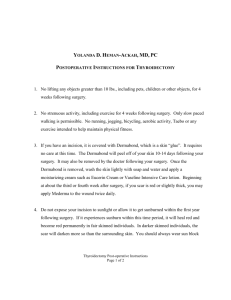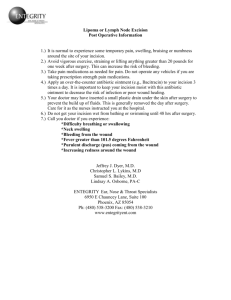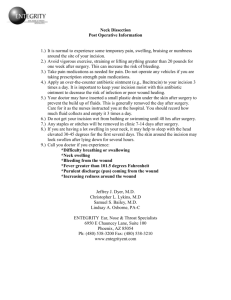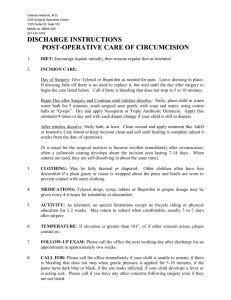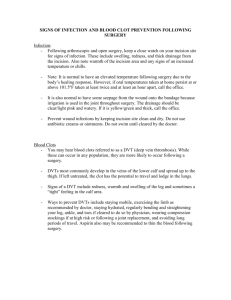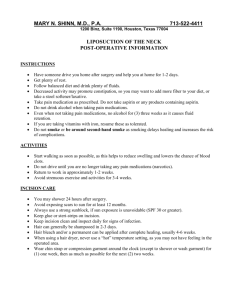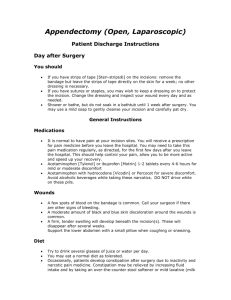is minimal incision thyroid surgery a better alternative to
advertisement
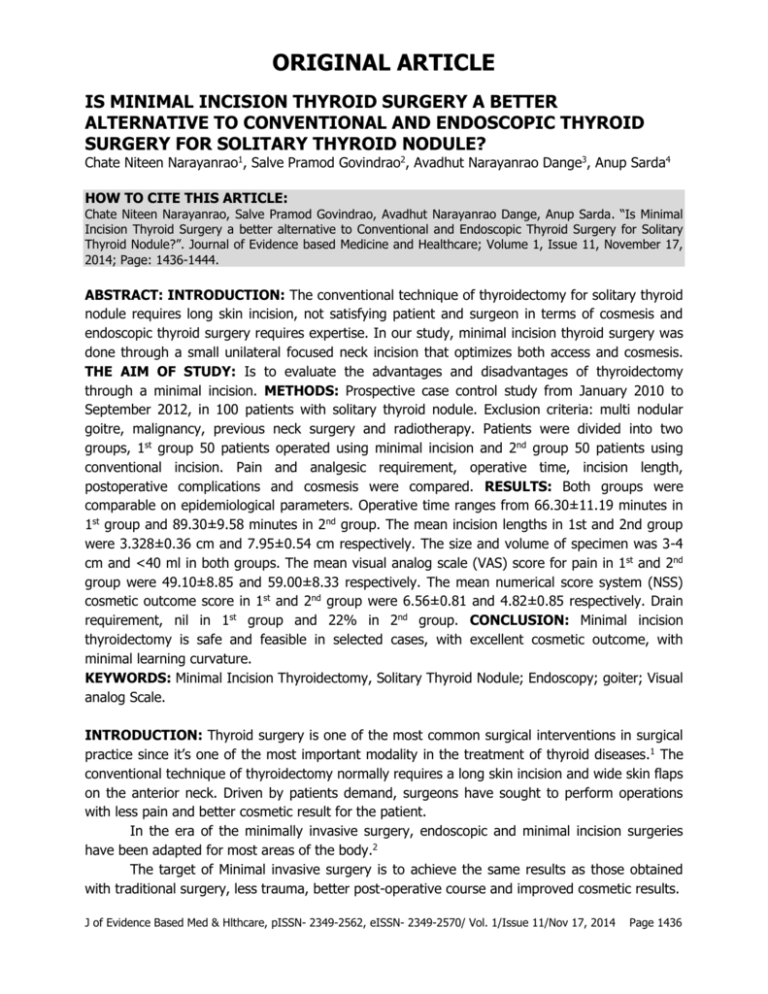
ORIGINAL ARTICLE IS MINIMAL INCISION THYROID SURGERY A BETTER ALTERNATIVE TO CONVENTIONAL AND ENDOSCOPIC THYROID SURGERY FOR SOLITARY THYROID NODULE? Chate Niteen Narayanrao1, Salve Pramod Govindrao2, Avadhut Narayanrao Dange3, Anup Sarda4 HOW TO CITE THIS ARTICLE: Chate Niteen Narayanrao, Salve Pramod Govindrao, Avadhut Narayanrao Dange, Anup Sarda. “Is Minimal Incision Thyroid Surgery a better alternative to Conventional and Endoscopic Thyroid Surgery for Solitary Thyroid Nodule?”. Journal of Evidence based Medicine and Healthcare; Volume 1, Issue 11, November 17, 2014; Page: 1436-1444. ABSTRACT: INTRODUCTION: The conventional technique of thyroidectomy for solitary thyroid nodule requires long skin incision, not satisfying patient and surgeon in terms of cosmesis and endoscopic thyroid surgery requires expertise. In our study, minimal incision thyroid surgery was done through a small unilateral focused neck incision that optimizes both access and cosmesis. THE AIM OF STUDY: Is to evaluate the advantages and disadvantages of thyroidectomy through a minimal incision. METHODS: Prospective case control study from January 2010 to September 2012, in 100 patients with solitary thyroid nodule. Exclusion criteria: multi nodular goitre, malignancy, previous neck surgery and radiotherapy. Patients were divided into two groups, 1st group 50 patients operated using minimal incision and 2nd group 50 patients using conventional incision. Pain and analgesic requirement, operative time, incision length, postoperative complications and cosmesis were compared. RESULTS: Both groups were comparable on epidemiological parameters. Operative time ranges from 66.30±11.19 minutes in 1st group and 89.30±9.58 minutes in 2nd group. The mean incision lengths in 1st and 2nd group were 3.328±0.36 cm and 7.95±0.54 cm respectively. The size and volume of specimen was 3-4 cm and <40 ml in both groups. The mean visual analog scale (VAS) score for pain in 1st and 2nd group were 49.10±8.85 and 59.00±8.33 respectively. The mean numerical score system (NSS) cosmetic outcome score in 1st and 2nd group were 6.56±0.81 and 4.82±0.85 respectively. Drain requirement, nil in 1st group and 22% in 2nd group. CONCLUSION: Minimal incision thyroidectomy is safe and feasible in selected cases, with excellent cosmetic outcome, with minimal learning curvature. KEYWORDS: Minimal Incision Thyroidectomy, Solitary Thyroid Nodule; Endoscopy; goiter; Visual analog Scale. INTRODUCTION: Thyroid surgery is one of the most common surgical interventions in surgical practice since it’s one of the most important modality in the treatment of thyroid diseases.1 The conventional technique of thyroidectomy normally requires a long skin incision and wide skin flaps on the anterior neck. Driven by patients demand, surgeons have sought to perform operations with less pain and better cosmetic result for the patient. In the era of the minimally invasive surgery, endoscopic and minimal incision surgeries have been adapted for most areas of the body.2 The target of Minimal invasive surgery is to achieve the same results as those obtained with traditional surgery, less trauma, better post-operative course and improved cosmetic results. J of Evidence Based Med & Hlthcare, pISSN- 2349-2562, eISSN- 2349-2570/ Vol. 1/Issue 11/Nov 17, 2014 Page 1436 ORIGINAL ARTICLE The patients were considered eligible for minimal invasive neck surgery according to some criteria, such as gland size and the kind of the disease3. In neck surgery different modalities were developed to replace the conventional technique of thyroidectomy in order to improve cosmetic results. These modalities include minimal invasive video assisted thyroidectomy (MIVAT), endoscopic thyroidectomy and lastly minimal incision thyroidectomy. This new technique is based on performing thyroid surgery through small conventional skin incision (from 2.5 to 4.5cm) using conventional instruments without any endoscopic instruments or videoscopic camera.4,5 The aim of this technique is to combine the advantage of better cosmetic results and better post-operative course gained by endoscopic surgery.6 AIM OF THE STUDY: The aim of the work is to evaluate the advantages and disadvantages of thyroidectomy through a small incision. Patients: Hundred patients with solitary thyroid nodule were admitted to the department of Surgery in Swami Ramanand Teerth Rural Govt. Medical College, Ambajogai between January 2010 to September 2012. Patients were randomly distributed in two groups: 1st Group: 50 patients underwent minimal incision thyroidectomy through a 2.5-4.5 cm incision. 2nd Group: 50 patients underwent conventional thyroidectomy. Inclusion Criteria: Patients with unilateral thyroid swelling, benign lesions, no previous neck surgery or radiotherapy, no pathological lymph node, nodule size ≤4 cm, thyroid volume ≤40 ml. Exclusion Criteria: Multinodular goitre, malignant lesions, previous history of neck surgery or radiotherapy. METHODS: All patients were submitted to thorough clinical history, general and local examinations. Laboratory investigation: Haemoglobin, bleeding time, clotting time and thyroid function tests. Plain X ray neck and superior mediastinum, ultrasound of neck were performed to detect size of the nodule and the gland. Indirect laryngoscopy for assessment of vocal cord movements. An informed written consent was taken from every patient. Surgical Techniques: 1st Group: Patients were operated upon using minimal incision thyroidectomy technique through unilateral focused neck incision along the skin crease 3 cm above the sternal notch, using a 2.54.5 cm incision5 (fig. 1 and fig. 2). 2nd Group: Patients were operated upon using conventional thyroidectomy technique (fig. 3). After the closure of the wound, the length of the incision is measured with the help of a measuring tape with a scale calibrated in millimeters. J of Evidence Based Med & Hlthcare, pISSN- 2349-2562, eISSN- 2349-2570/ Vol. 1/Issue 11/Nov 17, 2014 Page 1437 ORIGINAL ARTICLE The size of the excised thyroid tissue in the greatest diameter is measured with the help of measuring tape in centimeters and the volume of the removed sample is measured by the volume of water displaced by the thyroid tissue in a calibrated (in milliliters) glass beaker. At the end of the procedure, all the patients received a single 75 mg Diclofenac sodium intramuscular injection. In the post-operative period, the analgesia given to the patient was limited to an intramuscular injection of 50 mg of Diclofenac sodium administered on as and when required basis with a minimal interval of 6 hrs between two consecutive doses. The total number of doses till time of discharge is recorded. The patient is also asked to take a Visual Analog Scale (VAS) test for pain assessment 6 hours post-surgery, before administration of any analgesic. The results are recorded as a score ranging from 0 to 100, in increasing order of intensity of pain. 0 = no pain, 100= worst pain imaginable. The duration of post-operative hospital stay is recorded in days. Any complications are noted and the patient is explained and asked to grade the appearance of the cervical scar on a Numerical score system (NSS) of 0 to 10 in increasing order of satisfaction of the cosmetic outcome, with 0 = worst scar and 10= best cosmetic outcome. RESULTS: All 100 patients in both groups underwent hemithyroidectomy, results of which are as given below. The mean age in 1st group was 35.72±11.61 years and in the 2nd group was 37.60±10.31 years (p>0.05). 92% (46 out of 50) patients in the 1st group were females whereas, 90% (45 out of 50) patients in the 2nd group were females (p>0.05). Both the groups were comparable with respect to weight, height and BMI (p>0.05). Pre-operative FNAC in 1st group showed 72% colloid goitre and 28% follicular neoplasm whereas, 2nd group showed 66% colloid goitre and 34% follicular neoplasm (p>0.05). Skin incision in 1st group ranged from 2.5 cm to 4.5 cm, with the mean being 3.328±0.36 cm. While the mean skin incision length in the 2nd group was 7.950±0.54 cm (p<0.05). The operative time in the 1st group ranges between 45 – 90 minutes (mean – 66.30±11.19 minutes) and in the 2nd group ranges between 75 – 110 minutes (mean – 89.30±9.58 minutes) (p<0.05). The mean size of specimen in the 1st and 2nd groups were 3.616±0.39 cm and 3.672±0.40 cm respectively (p>0.05). The mean volume of specimen in the 1st and 2nd groups were 34.84±3.63 ml and 34.82±3.62 ml respectively (p>0.05). In our study, none of the patients in the 1st group required suction drain whereas, 22% (11 out of 50) patients in the 2nd group required suction drain (p=0.0004). The post-operative hospital stay in the 1st group ranges between 2 – 4 days (mean – 2.72±0.57 days) and in the 2nd group ranges between 3 – 6 days (mean – 4.04±0.72 days) (p<0.05). The Visual Analog Scale (VAS) pain score in the 1st group ranges between 30 – 65 (mean – 49.10±8.8) and in the 2nd group ranges between 45 – 85 (mean – 59.00±8.3) (p<0.05). The mean number of analgesic doses required in the 1st group and 2nd group are 2.86±076 and 4.14±0.88 respectively (p<0.05). J of Evidence Based Med & Hlthcare, pISSN- 2349-2562, eISSN- 2349-2570/ Vol. 1/Issue 11/Nov 17, 2014 Page 1438 ORIGINAL ARTICLE The Numerical score system (NSS) cosmetic outcome score in the 1st group ranges between 5 – 8 (mean – 6.56±0.81) and in the 2nd group ranges between 3 – 6 (mean – 4.82±085) (p<0.05). In the 1st group, 6 patients out of 50 (12%) had post-operative complications, which included RLN neuropraxia in 2 patients (recovered spontaneously), skin edge necrosis in 1 patient and seroma formation in 3 patients; whereas in the 2nd group, 8 patients out of 50 (16%) developed post-operative complications, which included primary haemorrhage in 1 patient (reexplored intra-operatively, feeding vessel ligated and suction drain kept), RLN neuropraxia in 4 patients (recovered spontaneously) and seroma formation in 3 patients. None of the complications except one required any active intervention. Thus, 6 patients in the 1st group and 8 patients in the 2nd group developed post-operative complications (p>0.05). In our study, histo-pathology report in 1st group showed 42% colloid goitre, 30% nodular goitre, 26% follicular adenoma and 2% follicular carcinoma (underwent completion thyroidectomy later on); whereas the 2nd group showed 48% colloid goitre, 20% nodular goitre, 32% follicular adenoma and 0% follicular carcinoma (p>0.05). DISCUSSION: There has been a recent surge of interest in the development of minimally invasive techniques in virtually every surgical specialty. It is widely recognized that smaller incisions with minimal disruption of tissue planes promote more rapid wound healing and yield more cosmetic and functional surgical results7. Keeping in line with the trends there has also been a recent surge of interest in the development of minimally invasive techniques in thyroid surgery.8 Thyroid diseases primarily occur in young to middle-age women, who usually are concerned with the cosmetic results after thyroid surgery. Driven by patient demand, surgeons had great interest to perform operation with less pain and better cosmetic results. To minimize cosmetically undesirable neck scars, several surgical groups have become interested in exploring the role of endoscopy in endocrine neck surgery. The main disadvantage of endoscopic neck surgery is long operative time, long learning curve and the need of advanced technical instruments. All of this made the endocrine surgeons to search for other methods5. Minimal incision thyroid surgery is one of these newer methods that provides improved cosmesis, reduced post-operative pain and hospital stay, without the need of advanced endoscopic instruments and specialized training. In our study, statistically no significant difference was observed in the epidemiological parameters like age, sex, weight, height, BMI and FNAC pathology (p>0.05). Size of Incision: The size of the incision used for performing the surgical procedure is usually the main differentiating factor between a minimally invasive procedure and a conventional procedure. This was appropriately brought out in the results of our study. The 1st group had an incision size of (mean ± standard deviation) 3.328±0.36 cm as compared to 7.950±0.54 cm of the 2nd group. This was statistically significant (p<0.05). Ikeda et al5 performed 21 operations of thyroidectomy through a 3 cm central incision. While Ferzli et al6 reported the length of the incision ranging from 2.5 cm to 10 cm with a mean of 4.2±0.2 cm, in which only 9% of patients had an incision extending beyond 4 cm. J of Evidence Based Med & Hlthcare, pISSN- 2349-2562, eISSN- 2349-2570/ Vol. 1/Issue 11/Nov 17, 2014 Page 1439 ORIGINAL ARTICLE The main reason for extension was the size of gland, which was in all these cases greater than 7 cm in diameter. Terris et al7 reported the mean length of incision for minimally invasive procedures as 4.9±1.0 cm. Park et al9 have reported a similar mean length of incision of 3.7±0.7 cm for their minimally invasive thyroid surgery procedures. Thus, our results are comparable to the results of the published literature. In our study, none of the patients required extension of incision, this could be attributed to proper selection of patients on the basis of pre-operative ultrasound. Size and volume of Lobe: Our study results show that, there was no statistically significant difference (p>0.05) between the two groups with respect to the mean size and volume of thyroid gland, which was removed by either the minimal incision approach or by the conventional method. This result assumes importance since it clearly demonstrates that cases, which were treated by a larger “collar” incision in the 2nd group, were potential candidates for treatment by the minimal incision approach. Operative Time: Our study results show that, the mean operative time in the 1st and 2nd group was 66.30±11.19 minutes and 89.30±9.58 minutes respectively, which was statistically significant (p<0.05). Ikeda et al5 reported the mean operative time of total lobectomy was 94±22 minutes. Terris et al7 reported a mean surgical time for minimally invasive hemithyroidectomy as 115.7±33.8 minutes, while for the conventional procedure it was 154.3±34.2 minutes. Perigli et al8 reported the operative time for lobectomy by the minimal incision approach and by the conventional approach reported the surgical time to be 39.9 minutes and 38.4 minutes respectively. Park et al9 reported a time of 57.6±11.7 minutes for the minimally invasive open procedure as compared with 85.2±32.3 minutes for the conventional procedure. Our study findings show that less operative time is required for minimal incision group than the conventional incision group. This may be due to limited incision and dissection required to reach the thyroid gland, no placement and fixation of drain and less time for closure required in the minimal incision group. Drain Requirement: Our study also brings out the fact that the number of patients requiring post-operative drain placement in the wound was significantly different in both the groups. 22% cases required it in the 2nd group and 0% in the 1st group (p=0.0004 which is <0.05). This supports the conclusion of Park et al9, where number of patients undergoing conventional thyroid surgery had a significantly higher rate of drain placement. No requirement of suction drain adds to the economic advantage in government surgical setup. Post-operative hospital Stay: Minimally invasive surgery techniques have traditionally been associated with many post-operative benefits in terms of short post-operative hospital stay and less post-operative pain. Our results demonstrate that the same holds true even in case of minimal incision thyroid surgery. The patients in the 1st group had a significantly shorter postoperative hospital stay, a mean of 2.72±0.57 days in contrast to 4.04±0.73 days in the 2nd group (p<0.05). Terris et al7, Perigli et al8 and Park et al9 reported mean duration of hospital stay J of Evidence Based Med & Hlthcare, pISSN- 2349-2562, eISSN- 2349-2570/ Vol. 1/Issue 11/Nov 17, 2014 Page 1440 ORIGINAL ARTICLE ranging from 21 to 48 hours. The mean duration of hospital stay in our study was relatively longer as compared to published literature as most of the patients in our study were from rural area, with low socio-economic status and education levels, requiring greater level of care. Hence, comparatively longer duration of hospital stay. Post-operative pain and analgesic Requirement: Mean visual analog scale (VAS) scores for 1st and 2nd group were 49.10±8.85 and 59.00±8.33 respectively, while the mean number of analgesic doses required was 2.86±0.76 and 4.14±0.88 respectively. Thus, patients in the 1st group were more comfortable in the post-operative period. Perigli et al8 have shown the mean VAS scores (0-10) following lobectomy by minimal incision thyroid surgery approach and conventional thyroid surgery to be 5.0 and 8.3 respectively. Statistically there was significant difference between both groups as regard post-operative pain and analgesic requirement (p<0.05). This could be attributed to smaller length of incision, less dissection, less destruction of tissues and the platysma was divided for smaller length. Cosmetic Outcome: Minimally invasive thyroid surgery not only improves post-operative comfort levels, but also scores major points on the cosmetic front. Perigli et al8 utilized the numerical score method and found significant difference between the minimally invasive group and the conventional group but no significant difference between video assisted and minimal incision thyroidectomy. Our study too utilized the numerical score system (NSS) and found significant cosmetic difference between the 1st and 2nd group, with mean scores of 6.56±0.81 and 4.82±0.85 respectively (p<0.05). Thus, minimal incision thyroid surgery is more attractive both to the surgeon and patient alike as it offers better cosmetic results. By our study, we emphasize provision of cosmesis to every patient in whom it is possible, not just on demand. In most cases of solitary thyroid nodules, no further treatment is required once lobectomy has been done, as most patients have benign lesions and these patients mostly seek medical advice due to unsightly appearance of swelling. Post-operative Complications: In our study, no significant difference was noted between the 1st and 2nd group with respect to post-operative complications. The 1st group had minor complications in 6 patients while in the 2nd group, 8 patients developed complications (p>0.05). Park et al9 also reported no significant difference in the complication rate in the minimal incision surgery group as compared to conventional surgery group while, Perigli et al8 have found the minimally invasive group to have fewer complications. It can thus be said that minimally invasive thyroid surgery procedures are as safe as the conventional procedures. Cost Effectiveness: Other forms of thyroid surgery like endoscopic thyroid surgery and minimal incision video assisted thyroid surgery (MIVAT) require special instrumentation and training. Whereas minimal incision non-endoscopic thyroid surgery uses conventional instruments with retraction. Thus, even though endoscopic thyroid surgery and MIVAT reduce the hospital stay, economic burden on patients is not reduced due to requirement of specialized instruments and J of Evidence Based Med & Hlthcare, pISSN- 2349-2562, eISSN- 2349-2570/ Vol. 1/Issue 11/Nov 17, 2014 Page 1441 ORIGINAL ARTICLE training. Whereas minimal incision non-endoscopic thyroid surgery not only reduces the hospital stay, but also does not impose additional expenses of specialized instrumentation and additional training on patients as well as surgeons. The minimal incision thyroidectomy seems to be suitable for thyroid disease than other new modalities in minimal access thyroid surgery, since this procedure is characterized by a small skin incision in the neck and the use of conventional instruments, retractors and a surgeon’s finger. Improvement in finger-eye coordination simplifies the procedure, enabling the procedure to be less technically demanding and time-consuming. Minimal incision thyroidectomy, has its limitations, the most important limiting factor is the size of the gland and it’s not suitable for recurrent goitre due to extensive adhesions, it still remains controversial if minimal incision technique can be suitable for management of thyroid carcinoma or not. CONCLUSIONS: Our study, thus establishes the safety and feasibility of a unilateral, nonendoscopic, minimal incision approach for hemithyroidectomy in selected patients. It also highlights its advantages over the conventional “collar” incision approach with respect to a shorter post-operative recovery period with significantly less pain and a superior cosmetic outcome with a smaller post-operative scar. There is no requirement of suction drains in the minimal incision group, which along with shorter hospital stay provides an economic advantage in rural government surgical setup. Since the technique is an evolution of the conventional procedure, it does not have a steep learning curve and also does not require any specialized instruments and training. However, it only appends and does not replace the conventional surgical approach that is required for very large lesions of the thyroid gland. REFERENCES: 1. Delbridge L. Total thyroidectomy: The evolution of surgical technique. ANZ J Surg 2003; 73: 761-8. 2. Gagner M. Endoscopic subtotal parathyroidectomy in patients with primary hyperparathyroidism. Br J Surg 1996; 875: 83. 3. Ruggieri M, Straniero A, Mascara A, Genderini M, D'Armiento M, Gargeulo P, Fumarola A, Trimboli P. The minimally invasive open video-assisted approach in surgical thyroid diseases. BMC Surg 2005; 5: 9. 4. Park CS, Chung WY, Chang HS. Minimally invasive open thyroidectomy. Surg Today 2001; 31: 665–9. 5. Ikeda Y, Takami H, Sasaki Y, Tajima G, Sasaki Y, Takayama J, Kurihara H, Niimi M. Direct mini-incision thyroidectomy. Biomed Pharmacother 2002; 56 Suppl 1:60s-3s. 6. Ferzli GS, Sayad P, Abdo Z, Cacchione RN. Minimally invasive, non-endoscopic thyroid surgery. J Am Coll Surg 2001; 192:665–8. 7. Terris DJ, Bonnett A, Gourin CG, Chin E. Minimally invasive thyroidectomy using the Sofferman technique. Laryngoscope 2005; 115 (6):1104-8. 8. Perigli G, Cortesini C, Qirici E, Boni D, Cianchi F. Clinical benefits of minimally invasive techniques in thyroid surgery. World J Surg Jan 2008; 32 (1): 45-50. J of Evidence Based Med & Hlthcare, pISSN- 2349-2562, eISSN- 2349-2570/ Vol. 1/Issue 11/Nov 17, 2014 Page 1442 ORIGINAL ARTICLE 9. Park CS, Chung WY, Chang HS. Minimally invasive open thyroidectomy. Surg Today 2001; 31 (8): 665-9. Fig. 1: Hemi-thyroidectomy through minimal incision Fig. 3: Final scar after minimal incision thyroidectomy Fig. 2: Size of the wound in minimal incision thyroidectomy Fig. 4: Final scar after conventional incision thyroidectomy J of Evidence Based Med & Hlthcare, pISSN- 2349-2562, eISSN- 2349-2570/ Vol. 1/Issue 11/Nov 17, 2014 Page 1443 ORIGINAL ARTICLE Fig. 5 AUTHORS: 1. Chate Niteen Narayanrao 2. Salve Pramod Govindrao 3. Avadhut Narayanrao Dange 4. Anup Sarda PARTICULARS OF CONTRIBUTORS: 1. Associate Professor, Department of General Surgery, Swami Ramanand Teerth Government Rural Medical College, Ambajogai District, Beed, Maharashtra. 2. Associate Professor, Department of General Surgery, Swami Ramanand Teerth Government Rural Medical College, Ambajogai District, Beed, Maharashtra. 3. Assistant Professor, Department of General Surgery, Swami Ramanand Teerth Government Rural Medical College, Ambajogai District, Beed, Maharashtra. 4. Resident, Department of General Surgery, Swami Ramanand Teerth Government Rural Medical College, Ambajogai District, Beed, Maharashtra. NAME ADDRESS EMAIL ID OF THE CORRESPONDING AUTHOR: Dr. Chate Niteen Narayanrao, Associate Professor, Department of General Surgery, Swami Ramanand Teerth Government Rural Medical College, Ambajogai District, Beed, Maharashtra. E-mail: nittinchate@gmail.com Date Date Date Date of of of of Submission: 17/10/2014. Peer Review: 18/10/2014. Acceptance: 26/10/2014. Publishing: 15/11/2014. J of Evidence Based Med & Hlthcare, pISSN- 2349-2562, eISSN- 2349-2570/ Vol. 1/Issue 11/Nov 17, 2014 Page 1444
